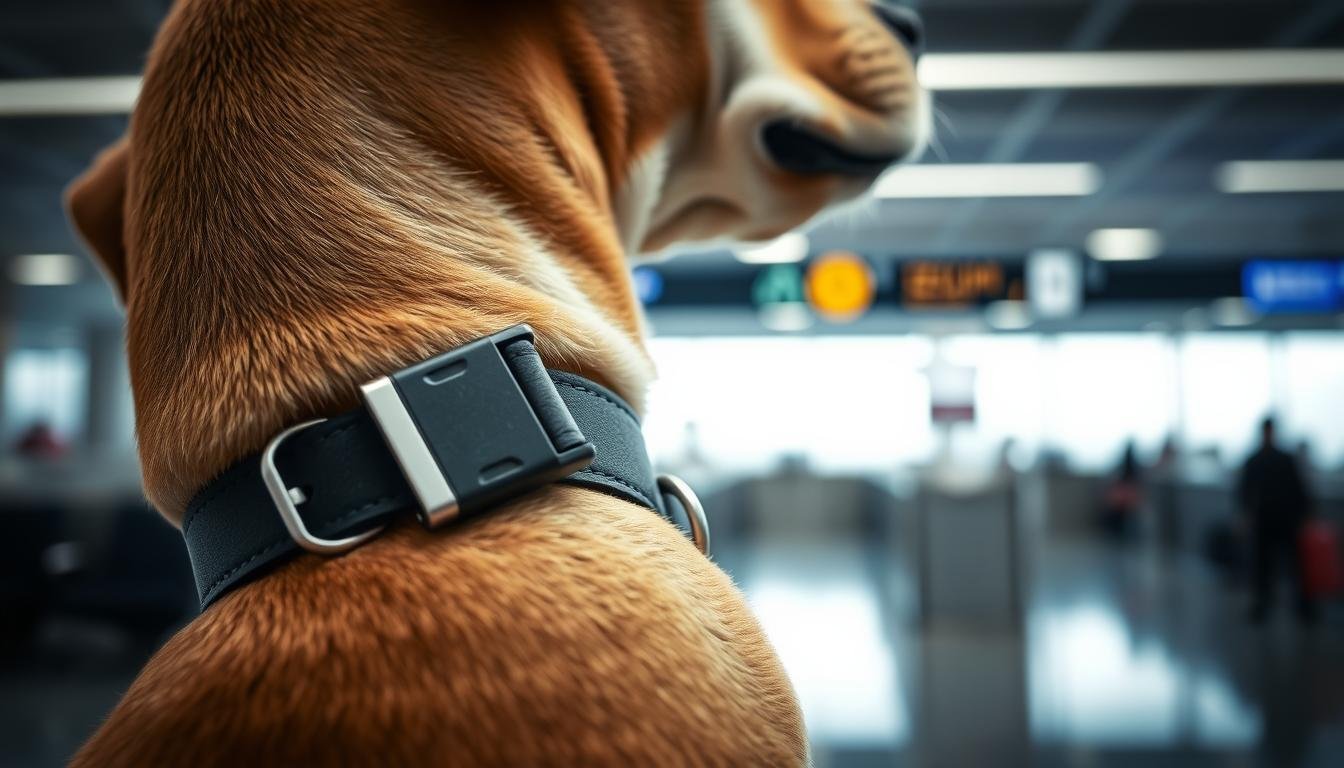Bring a Dog Shock Collar on a Plane: Traveling with your pet can be tough, especially with TSA regulations to follow. You also need to make sure your dog’s training device is okay for flying.
Pet owners use dog shock collars to keep their pets in line. But, flying raises questions about if these devices are allowed.
This article will look into the rules for taking dog shock collars on planes. It aims to help you have a hassle-free trip with your pet.
Contents
- 1 Understanding Dog Shock Collars and Their Types
- 2 TSA Regulations on Dog Training Devices
- 3 Can You Bring a Dog Shock Collar on a Plane?
- 4 Traveling with Your Dog and Training Equipment
- 5 Practical Tips for Flying with Dog Training Devices
- 6 Traveling with Your Dog: Final Considerations
- 7 FAQ: Bring a Dog Shock Collar on a Plane
- 7.1 Can I bring a dog shock collar on a plane?
- 7.2 Are dog shock collars allowed in carry-on luggage?
- 7.3 Do I need to remove my dog’s shock collar during the flight?
- 7.4 Can I use a dog shock collar on a plane?
- 7.5 How should I pack my dog’s shock collar for a flight?
- 7.6 Are there any specific TSA regulations for dog training devices?
Understanding Dog Shock Collars and Their Types
Dog shock collars, also known as e-collars, are used in dog training. They help change a dog’s behavior through different stimuli.
There are many types of dog shock collars. Each has its own purpose and features. The main types are static stimulation collars, vibration collars, and spray collars.
Static Stimulation Collars
Static stimulation collars are very common. They give a mild electric shock to the dog when the owner presses a button. This shock is meant to stop bad behavior and get the dog’s attention.
How well these collars work depends on how they are used. Dog owners need to know how to use them right to avoid hurting their pets.
Knowing about different dog shock collars helps owners choose the right one for their dog. Whether you’re experienced or new to dog training, picking the right collar is key. It ensures your dog gets the best training.
TSA Regulations on Dog Training Devices
Traveling with dog training equipment needs you to know TSA rules to avoid problems. The Transportation Security Administration has clear guidelines for devices like shock collars. These rules help keep everyone safe while flying.
Before flying with your dog’s training gear, it’s key to know what’s allowed. Most dog training devices can go in carry-on or checked luggage. But, there are some rules to keep in mind.
For example, items with batteries or lithium-ion batteries face special rules. It’s recommended to check with your airline about these items. Airlines might have different rules.
The TSA lets most dog training devices through, but some might need extra checks. Or they might have special rules.
| Device Type | Allowed in Carry-On | Allowed in Checked Luggage |
|---|---|---|
| Shock Collars | Yes | Yes |
| Vibration Collars | Yes | Yes |
| Devices with Lithium Batteries | Yes, with restrictions | Yes, with restrictions |
Always check the TSA’s website for the latest rules. Also, talking to your airline before your trip can make things easier. This way, you can enjoy your flight with your dog’s training gear.
Can You Bring a Dog Shock Collar on a Plane?
Traveling with your dog can raise questions, like whether you can bring a dog shock collar on a plane. The answer depends on the airline’s policies.
Airlines have different rules for electronic devices, including dog shock collars. It’s important to check with your airline before flying to know their rules.
Policies on Electronic Devices
Airlines have specific guidelines for electronic devices, like those for pet training. Some allow them in carry-on bags, while others need them checked.
| Airline | Policy on Dog Shock Collars | Additional Requirements |
|---|---|---|
| American Airlines | Allowed in carry-on | Must be turned off during flight |
| Delta Airlines | Allowed in checked luggage | Battery must be removed and protected |
| United Airlines | Allowed in carry-on | Must be in a protective case |
Think about your dog’s shock collar safety during travel. Make sure it’s secure and won’t get damaged or turned on by accident.
Knowing the airline’s policies and taking care can help you travel safely with your dog’s shock collar.
Traveling with Your Dog and Training Equipment
Traveling with your dog needs careful planning, especially for their training devices. Whether it’s a weekend trip or a longer vacation, make sure your dog’s training gear is travel-ready.
Before packing, check with your airline about pet training devices. Some items, like dog shock collars, might have special rules or needs for travel.

Here’s a helpful table to consider when preparing your dog’s training equipment for travel:
| Equipment | Packing Tip | Travel Consideration |
|---|---|---|
| Dog Shock Collar | Pack in a protective case | Check airline restrictions |
| Training Pads | Pack extra supplies | Dispose of properly during travel |
| Leash and Harness | Keep easily accessible | Ensure comfort during travel |
By planning ahead and understanding your dog’s training equipment needs, you can make your journey smoother for both you and your pet.
Practical Tips for Flying with Dog Training Devices
Traveling with a dog shock collar on a plane needs special care for a smooth trip. It’s important to think about how to manage your dog’s training device during the flight.
First, think about the safety and comfort of your dog and others around you. Make sure your dog’s shock collar fits right and doesn’t cause stress or discomfort. This is especially true during the flight.
Before you fly, check with your airline about rules for dog training devices. Some airlines have special rules or requirements for these devices on board.
During the flight, keep your dog’s shock collar handy in case you need to adjust it. It’s also smart to use a comfy, well-ventilated harness for your dog. This helps prevent chafing or irritation from the collar.
Here are some in-flight tips: keep your dog calm and relaxed. Only use the shock collar if it’s really necessary. Be ready to talk to flight attendants or other passengers if they have concerns.
Being prepared and considerate of others helps make the flight safe and enjoyable for you and your dog.
Traveling with Your Dog: Final Considerations
When you plan to travel with your dog, it’s important to know about TSA rules. These rules affect whether you can bring a dog shock collar on a plane.
Before you go, check with your airline about their dog and training equipment policies. This helps ensure a smooth trip for you and your pet.
Knowing TSA rules and airline policies helps avoid travel problems. This knowledge lets you prepare better, making your trip less stressful.
Think about your dog’s needs and the training equipment you use. With the right info, you can have a stress-free trip with your pet.
See Also: Can You Bring a Fake Sword on a Plane?
FAQ: Bring a Dog Shock Collar on a Plane
Can I bring a dog shock collar on a plane?
Yes, you can bring a dog shock collar on a plane. But, first, check your airline’s rules on electronic devices. Also, make sure you follow TSA regulations.
Are dog shock collars allowed in carry-on luggage?
Dog shock collars are usually okay in carry-on luggage. Still, tell the TSA officer at security. Also, check with your airline for any special rules.
Do I need to remove my dog’s shock collar during the flight?
It’s best to keep your dog’s shock collar on during the flight. Just make sure it’s in safe mode to avoid any shocks.
Can I use a dog shock collar on a plane?
No, you shouldn’t use a dog shock collar on the plane. It might upset your dog or bother other passengers.
How should I pack my dog’s shock collar for a flight?
Pack your dog’s shock collar safely to avoid damage. Use a protective case or wrap it well to stop it from turning on by accident.
Are there any specific TSA regulations for dog training devices?
The TSA lets dog training devices, like shock collars, in both carry-on and checked luggage. Just be ready to explain it and its use at security.

Hello, I’m Janiyah Gibbs—a retired flight crew member and former TSA officer from Alaska, USA. At PlaneCarry.com, I share expert insights on what to carry (and avoid) when flying.

